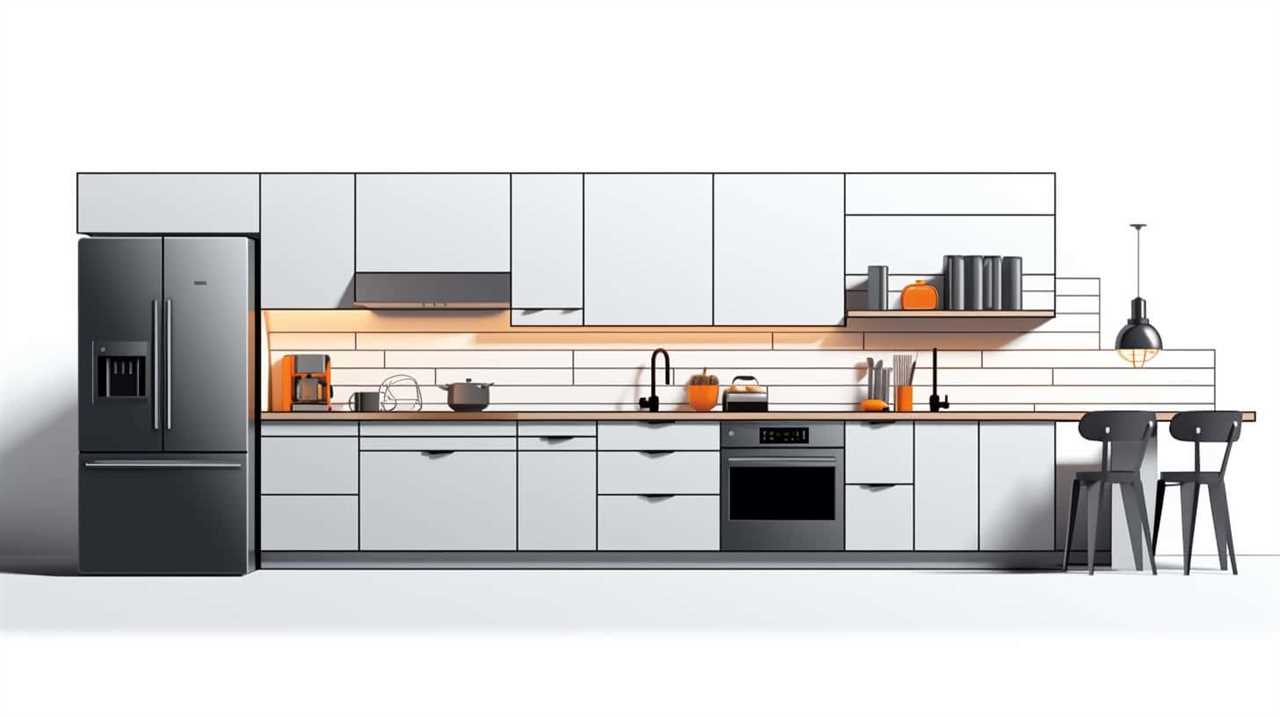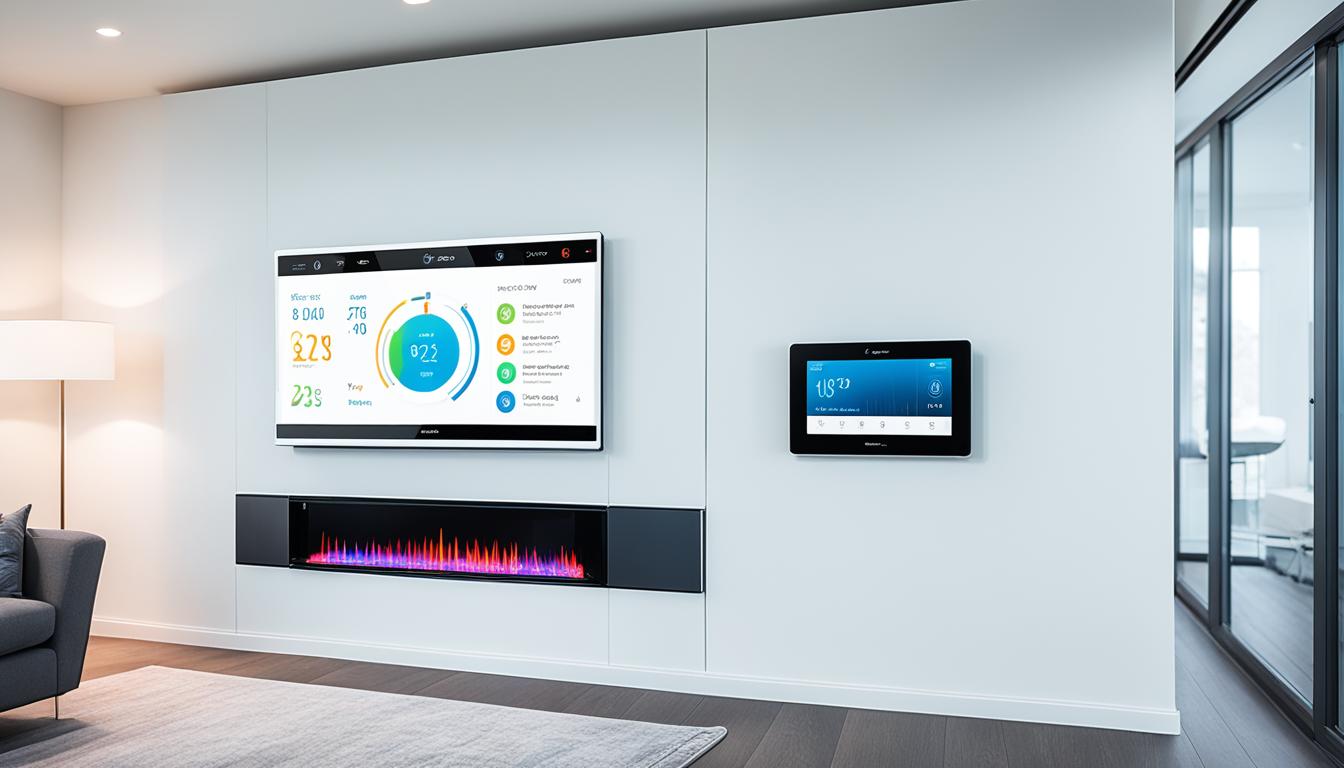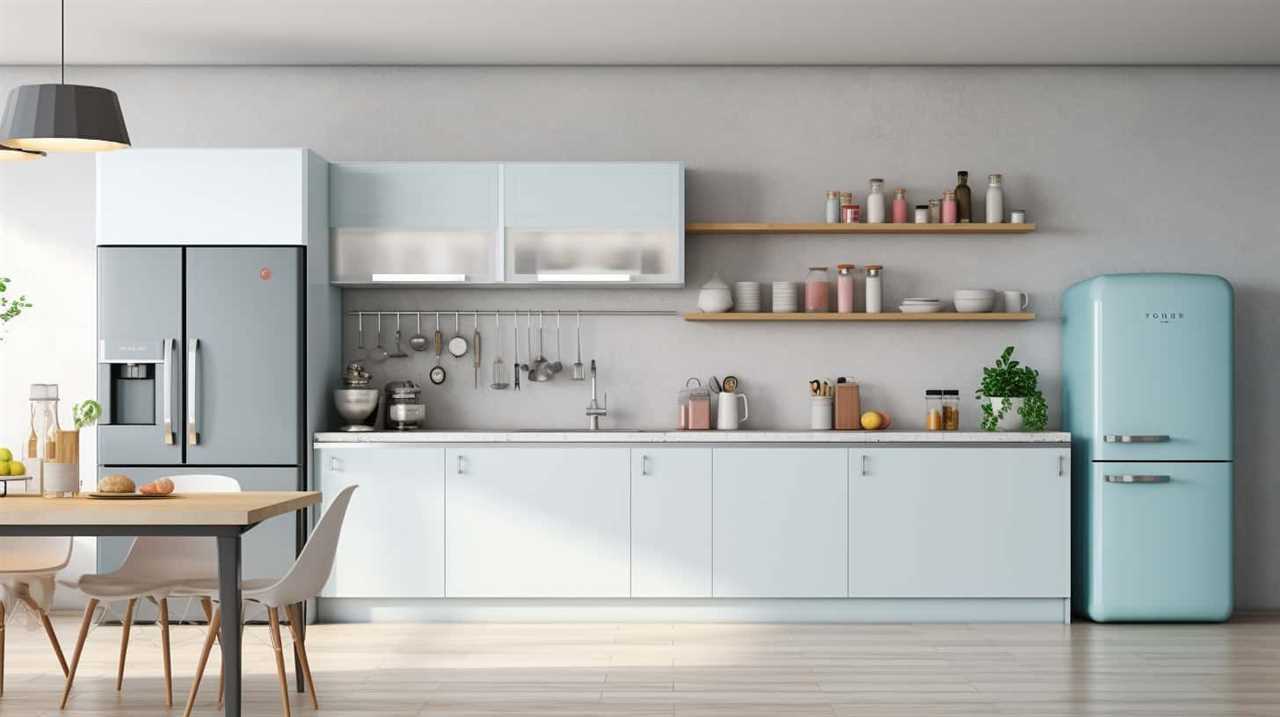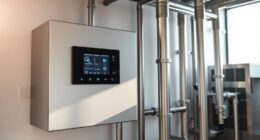Are you tired of struggling with your smart home appliances and wishing for a smooth integration experience? Look no further! In this guide, we will share 11 reliable ways to seamlessly integrate your smart home appliances, enhancing your home automation skills.
From Wi-Fi connectivity to voice control integration options, we’ve got you covered. Discover the power of smart home hubs and their role in integration, as well as how to integrate your appliances with home security systems.
Learn the art of creating a central control hub and explore the possibilities of integrating your smart appliances with other IoT devices. Plus, we’ll provide troubleshooting tips for common integration issues.
Get ready to transform your home into a fully connected, efficient, and futuristic haven. Let’s dive in!

Key Takeaways
- Compatibility between smart home appliances is essential for seamless integration
- Investing in a centralized hub or controller can improve compatibility and simplify home automation
- Voice control integration through virtual assistants allows for hands-free interaction with devices
- Integrating smart home appliances with home security systems enhances monitoring and security capabilities
Smart Home Appliance Compatibility
To ensure a smooth integration of smart home appliances, we need to consider their compatibility with each other. Smart home appliance compatibility is crucial for creating a seamless and interconnected network of devices in our homes. When it comes to integrating different smart appliances, compatibility issues can arise, leading to frustrating experiences and potential malfunctions.
Troubleshooting common compatibility issues requires a deep understanding of the technologies involved. It’s essential to ensure that the devices you choose are designed to work together and follow the same communication protocols. For instance, devices that support the Zigbee or Z-Wave protocols are more likely to be compatible with each other.
In some cases, firmware updates can solve compatibility issues. Manufacturers often release updates to improve compatibility and address any bugs that may affect the seamless integration of devices. Regularly checking for firmware updates and applying them when available can help resolve compatibility problems.
Another important aspect of smart home appliance compatibility is the availability of a centralized hub or controller. Investing in a hub that supports multiple communication protocols can help bridge the gap between incompatible devices and improve overall compatibility. These hubs act as intermediaries, translating signals between devices and enabling seamless communication.

Wi-Fi Connectivity for Seamless Integration
One way we can achieve seamless integration of smart home appliances is by ensuring a reliable Wi-Fi connectivity. A strong and stable Wi-Fi connection provides numerous benefits that enhance the overall smart home experience.
Here are four key reasons why Wi-Fi connectivity is crucial for seamlessly integrating smart home appliances:
- Effortless Control: A reliable Wi-Fi connection allows you to effortlessly control your smart home appliances from anywhere in your house. Whether it’s adjusting the thermostat, turning off the lights, or starting the dishwasher, you can conveniently manage your devices with just a few taps on your smartphone.
- Real-Time Monitoring: With Wi-Fi connectivity, you can monitor your smart appliances in real-time. Receive notifications when your laundry is done, check your security cameras remotely, or get alerts if there’s a water leak in your home. Stay connected and informed about your appliances’ status, ensuring peace of mind.
- Seamless Integration: Wi-Fi connectivity enables seamless integration between different smart home appliances. Connect your smart speaker to your smart lights, your smart thermostat to your smart blinds, and create customized routines that automate your home for maximum comfort and convenience.
- Troubleshooting Connection Issues: In case of any connection issues, a reliable Wi-Fi network allows for easier troubleshooting. You can quickly identify and resolve any connectivity problems, ensuring that your smart appliances stay connected and functional.
Voice Control Integration Options
How can we incorporate voice control into our smart home appliances?
Voice control options have become increasingly popular in smart homes, offering a convenient and hands-free way to interact with our devices. One of the key factors to consider when integrating voice control is virtual assistant compatibility. Virtual assistants like Amazon Alexa, Google Assistant, and Apple Siri have voice control capabilities and can be seamlessly integrated with various smart home appliances.

When choosing voice control options, it’s important to ensure that the appliances are compatible with the virtual assistant you prefer. This compatibility allows you to control your devices using voice commands, such as adjusting the temperature, turning on lights, or playing music. Many smart home appliances now come with built-in virtual assistant support, making it easier to incorporate voice control into your home.
By utilizing voice control options and virtual assistant compatibility, you can create a more intuitive and seamless smart home experience. Imagine being able to control multiple appliances with a simple voice command, creating an effortless and efficient living environment.
Now that we’ve explored voice control integration options, let’s move on to discussing smart home hubs and their role in integration.
Smart Home Hubs and Their Role in Integration
Smart home hubs play a crucial role in seamlessly integrating smart home appliances. These hubs offer a range of benefits, including centralizing control and providing a single point of access for all connected devices.

With their compatibility with various devices, smart hubs ensure that different brands and protocols can work together harmoniously. By simplifying home automation, smart hubs make it easy for users to manage and control their smart home appliances with ease and convenience.
Benefits of Smart Hubs
We have found that using a smart home hub greatly enhances the integration of smart home appliances. Smart hubs offer a range of advantages and features that make them a valuable addition to any smart home setup. Here are four reasons why smart hubs are beneficial:
- Centralized Control: A smart hub serves as a centralized control center for all your connected devices, allowing you to manage and control them from a single interface.
- Improved Compatibility: Smart hubs are designed to work with various protocols and standards, ensuring compatibility with a wide range of smart devices, regardless of their brand or manufacturer.
- Automation and Scenes: Smart hubs enable the creation of automation rules and scenes, allowing you to automate routine tasks and create personalized settings that can be triggered with a single command.
- Enhanced Security: Many smart hubs come with built-in security features, such as encryption and firewall protection, ensuring the safety and privacy of your smart home devices and data.
Compatibility With Devices
Our smart home hubs play a crucial role in integrating various devices, ensuring compatibility and seamless connectivity. These hubs act as a bridge, allowing different devices to communicate with each other and work harmoniously. They support various communication protocols, such as Wi-Fi, Zigbee, and Z-Wave, enabling them to connect with a wide range of devices.
When it comes to smart home appliance compatibility issues, smart home hubs serve as the central command center that brings all the devices together. They support various communication protocols, such as Wi-Fi, Zigbee, and Z-Wave, enabling them to connect with a wide range of devices. Additionally, smart home hubs often come with built-in compatibility with popular voice assistants like Amazon Alexa or Google Assistant, making it even easier to control your smart home devices with just your voice.

Troubleshooting smart home integration can sometimes be a challenge, but with the right smart home hub, compatibility issues can be minimized, ensuring a seamless and hassle-free experience.
Simplifying Home Automation
The key to simplifying home automation lies in seamlessly integrating smart home hubs and their role in device compatibility and connectivity. Smart home hubs act as the central control point for all smart devices in the home, allowing for easy management and automation.
Here are four ways in which smart home hubs simplify home automation:
- Device Compatibility: Smart home hubs support a wide range of smart devices, ensuring that your appliances can communicate and work together seamlessly.
- Centralized Control: With a smart home hub, you can control all your smart devices from a single app or interface, eliminating the need for multiple apps and simplifying the management of your automated home.
- Automation and Scenes: Smart home hubs allow you to create customized automation routines and scenes, enabling you to control multiple devices with a single command or trigger.
- Remote Access: With a smart home hub, you can remotely monitor and control your home automation system from anywhere, providing convenience and peace of mind.
Integration With Home Security Systems
When it comes to integrating smart home appliances with home security systems, there are several key points to consider.

First and foremost, the benefits of integration can’t be overstated. By connecting your security system to your smart home network, you can enjoy enhanced control and monitoring capabilities.
Secondly, it’s crucial to ensure that your security system is compatible with your smart home hub. This will ensure seamless communication and functionality between the two systems.
Lastly, proper installation and setup are essential for a smooth integration process. Taking the time to follow the manufacturer’s instructions and seeking professional assistance if needed will help avoid any potential issues.
Benefits of Integration
As we explore the benefits of integrating smart home appliances, it becomes evident that incorporating them with home security systems enhances the overall safety and protection of our living spaces.

Here are four advantages of this integration:
- Enhanced monitoring: Integrating smart home appliances with home security systems allows for real-time monitoring of the premises. This means you can receive instant alerts on your smartphone if any suspicious activity is detected.
- Increased deterrence: By combining smart home appliances with home security systems, you create a more formidable deterrent for potential intruders. The presence of security cameras, smart locks, and motion sensors can discourage break-ins and protect your property.
- Seamless automation: Integration enables seamless automation between your smart home appliances and security systems. For example, you can program your lights to turn on automatically when the security system detects motion, creating the illusion of an occupied home.
- Peace of mind: With the integration of smart home appliances and home security systems, you can have peace of mind knowing that your living space is well-protected. The ability to remotely monitor and control your security features provides a sense of control and reassurance.
Compatible Security Systems
To fully integrate smart home appliances, it’s important to consider the compatibility of these devices with various home security systems. Compatible security cameras play a crucial role in ensuring the safety and security of your home. By integrating these cameras with your smart home system, you can monitor your property remotely and receive real-time alerts in case of any suspicious activity.
This integration allows you to have a comprehensive view of your home’s security, giving you peace of mind wherever you are. In addition to the obvious security benefits, integrating compatible security cameras with your smart home system also offers home automation benefits. For example, you can set up rules and automation routines that trigger specific actions when certain security events occur, such as turning on lights when motion is detected.
Installation and Setup
We can ensure a seamless integration with home security systems by following a simple installation and setup process. To help you with this, here are some installation tips and troubleshooting issues you may encounter:

- Plan the installation: Before starting, assess your home security system and determine the best location for the smart home appliances. Ensure that all necessary equipment is available and compatible.
- Follow instructions carefully: Read the installation manuals provided by the smart home appliance manufacturers. Follow the step-by-step instructions to connect and configure the devices properly.
- Test the system: After installation, test the integration with your home security system. Ensure that all devices are communicating correctly and that you can control them through the security system’s interface.
- Troubleshoot connectivity issues: If you experience connectivity problems, check the Wi-Fi signal strength, reset the devices if necessary, and ensure that the firmware is up to date. If issues persist, consult the manufacturer’s support or seek professional assistance.
Automating Routines With Smart Home Appliances
By using smart home appliances, we can effortlessly automate our daily routines. One of the key benefits of smart home technology is the ability to automate schedules, making our lives more convenient and efficient. With the advancement of Internet of Things (IoT) technology, we can easily integrate various smart devices and create a seamless network of automation.
Automating routines with smart home appliances not only saves time and effort, but also promotes energy efficiency. For instance, we can program our smart thermostats to adjust the temperature based on our daily schedule. This ensures that the heating or cooling is optimized when we’re at home, and reduces energy consumption when we’re away.
In addition to controlling the temperature, we can automate other aspects of our routines. Smart lighting systems can be programmed to turn on and off at specific times, creating a welcoming ambiance when we arrive home. Similarly, smart appliances such as coffee makers and ovens can be scheduled to start brewing or cooking before we even wake up or return home, allowing us to enjoy a fresh cup of coffee or a hot meal without any effort.
Integrating Smart Appliances With Virtual Assistants
When it comes to integrating smart appliances with virtual assistants, there are numerous benefits to consider.

Virtual assistants like Amazon Alexa and Google Assistant can control and manage a wide range of smart home appliances, providing convenience and ease of use.
Additionally, compatibility is key, as not all smart appliances may work seamlessly with every virtual assistant.
To ensure a smooth integration, it’s important to follow some tips and guidelines.
Benefits of Virtual Assistants
Virtual assistants offer numerous benefits when integrating smart appliances into our homes. Here are four reasons why integrating virtual assistants with smart appliances can greatly enhance our living experience:

- Seamless control: Virtual assistants enable us to connect and control multiple smart devices with ease. By simply using voice commands or smartphone apps, we can effortlessly manage our appliances, saving us time and effort.
- Improved efficiency: With virtual assistants, we can automate and optimize the functions of our smart appliances. For example, we can set schedules for our thermostats, allowing them to adjust the temperature based on our preferences, ultimately reducing energy consumption and saving costs.
- Enhanced convenience: Virtual assistants can provide hands-free operation of our smart appliances. Whether we’re cooking in the kitchen or relaxing in the living room, we can effortlessly control our appliances without having to physically interact with them.
- Personalized experiences: Virtual assistants can learn our preferences and adapt to our needs. They can recommend recipes, suggest energy-saving settings, and even create personalized routines based on our daily habits, making our smart appliances work seamlessly to enhance our daily lives.
Compatibility With Smart Appliances
To seamlessly integrate smart appliances with virtual assistants, we need to ensure compatibility between the two.
One crucial aspect of compatibility is Wi-Fi compatibility. Smart appliances need to be able to connect to the internet via Wi-Fi in order to communicate with virtual assistants. This connectivity allows users to control their appliances remotely and receive real-time updates on their status.
Another important factor to consider is the voice control options available. Virtual assistants like Amazon Alexa and Google Assistant offer voice control capabilities, allowing users to simply speak commands to control their smart appliances. This feature enhances convenience and accessibility, as users can operate their appliances hands-free.
Tips for Seamless Integration
In order to seamlessly integrate smart appliances with virtual assistants, it’s important to consider the following tips:

- Choose compatible devices: Ensure that the smart appliances you purchase are compatible with the virtual assistant you use. This will ensure smooth communication and functionality between the devices.
- Set up a central hub: Use a central hub, such as a smart speaker or a smart display, to connect and control all your smart appliances. This will streamline the integration process and provide a unified control interface.
- Customize voice commands: Take advantage of the customization options offered by your virtual assistant to create personalized voice commands for your smart appliances. This will make it easier and more efficient to control them using voice commands.
- Update firmware and software: Regularly update the firmware and software of both your smart appliances and virtual assistant. This will ensure that you have access to the latest features, bug fixes, and security updates, improving the overall performance and reliability of the integration.
Smart Home Appliance Integration Through Mobile Apps
Through the use of mobile apps, we can seamlessly integrate our smart home appliances. These apps provide a range of features that allow us to control and manage our devices from anywhere at any time. With just a few taps on our smartphones, we can turn on the lights, adjust the thermostat, and even start the coffee maker before we even get out of bed.
Mobile app features for smart home appliances go beyond basic remote control options. They offer advanced functionalities that enhance our overall experience. For instance, some apps allow us to create personalized schedules for our appliances, so they automatically turn on or off at specific times. This not only adds convenience but also helps us save energy.
To give you a better understanding of the capabilities of mobile apps for smart home appliances, here is a table showcasing some popular features:
| Feature | Description |
|---|---|
| Remote control | Control your appliances from anywhere using your smartphone. |
| Scheduling | Set specific times for your appliances to turn on or off automatically. |
| Energy monitoring | Track energy usage and identify opportunities for energy savings. |
| Notifications | Receive alerts and notifications about your appliances’ status and activities. |
Mobile apps offer a user-friendly interface that makes it easy to interact with our smart home appliances. They provide convenience, energy efficiency, and peace of mind, all at our fingertips. With these apps, we can truly create a fully integrated and intelligent home.

Creating a Central Control Hub for Integration
We frequently rely on a central control hub to seamlessly integrate our smart home appliances, allowing us to easily manage and control them all from one centralized location. A central control hub is a vital component of a smart home system, providing a unified interface for controlling and monitoring various devices. Here are four central control options that can enhance your smart home experience:
- Voice-controlled assistants: Smart speakers like Amazon Echo or Google Home act as central control hubs, allowing you to use voice commands to control your smart devices. Simply speak a command, and your assistant will execute it.
- Smart home hubs: These devices connect to your home network and allow you to control your smart devices through a dedicated mobile app or web interface. They often support various communication protocols, enabling compatibility with a wide range of smart devices.
- Home automation software: Some smart home systems offer software solutions that serve as central control hubs. These applications provide advanced features like scheduling, automation, and customization options to enhance your control over your smart home appliances.
- Integrated control panels: Some home security systems or home automation systems come with integrated control panels. These panels act as a central hub, providing a physical interface with buttons or touchscreens to control your smart devices.
When integrating smart home appliances into a central control hub, it’s essential to troubleshoot any integration issues that may arise. Ensure that all devices are properly connected to the hub and that they’re compatible with the chosen control option. If problems persist, consult the manufacturer’s documentation or seek technical support to resolve any issues.
A central control hub simplifies the management of smart home appliances, streamlining your experience and providing a seamless integration of devices. By exploring different central control options and troubleshooting integration issues, you can create a more efficient and convenient smart home environment.
Integrating Smart Appliances With Other Iot Devices
To seamlessly integrate our smart home appliances with other IoT devices, let’s explore how different devices can communicate and work together. Integrating smart appliances with other IoT devices can sometimes present compatibility issues and integration problems. However, with the right approach and troubleshooting techniques, these issues can be overcome.

One way to integrate smart appliances with other IoT devices is through the use of a central control hub. This hub acts as a bridge between the different devices, allowing them to communicate and share information. By connecting all the devices to the hub, users can control and monitor their smart appliances from a single interface.
Another method is through the use of protocols such as Zigbee or Z-Wave. These wireless communication protocols enable smart appliances and other IoT devices to connect and interact with each other. By ensuring that all the devices in the network support the same protocol, compatibility issues can be minimized.
To help you understand the different ways smart appliances can be integrated with other IoT devices, here is a table showcasing some popular integration methods:
| Integration Method | Description |
|---|---|
| Central Control Hub | Connect all devices to a central hub that acts as a bridge for communication. |
| Wireless Protocols | Use protocols like Zigbee or Z-Wave to enable devices to connect and interact. |
| Voice Assistants | Integrate smart appliances with voice assistants like Amazon Alexa or Google Assistant. |
| Mobile Apps | Control and monitor appliances through dedicated mobile apps provided by manufacturers. |
When troubleshooting integration problems, it is important to check for firmware updates and ensure that all devices are running the latest software versions. Additionally, verifying compatibility between devices and checking for any known issues or limitations can help resolve integration problems.

Troubleshooting Common Integration Issues
One common integration issue that can arise is the lack of compatibility between smart appliances and other IoT devices. Troubleshooting common issues is essential to ensure a seamless integration of smart home appliances. Here are four key troubleshooting steps to help resolve connectivity problems:
- Verify compatibility: Check if the smart appliance and IoT device are compatible with each other. Ensure they use the same communication protocols and standards. Incompatible devices may require additional hardware or software updates to establish a connection.
- Check network settings: Confirm that both the smart appliance and IoT device are connected to the same network. Ensure that the network is functioning properly and has a stable internet connection. Troubleshoot any network issues such as weak signal or interference.
- Update firmware: Keep the firmware of both the smart appliance and IoT device up to date. Manufacturers often release firmware updates to improve compatibility and fix bugs. Check for updates regularly and install them to enhance the integration experience.
- Reset and restart: If all else fails, try resetting both the smart appliance and IoT device. This can help resolve any temporary glitches or conflicts. After resetting, restart both devices and attempt to reconnect them.
Frequently Asked Questions
Can I Integrate My Smart Home Appliances With Other Non-Iot Devices?
Yes, we can integrate our smart home appliances with other non-IoT devices. By connecting our smart appliances to a central hub or using compatible protocols like Zigbee or Z-Wave, we can seamlessly integrate them with devices such as TVs, sound systems, or even our existing home automation systems.
This integration provides us with numerous benefits, including enhanced control, automation, and convenience. All our devices work together harmoniously to create a truly smart and interconnected home.
What Are Some Common Integration Issues That Users Might Encounter With Smart Home Appliances?
When it comes to smart home appliances, common troubleshooting often revolves around compatibility issues. For example, users may encounter problems when trying to integrate their smart thermostat with their existing HVAC system. This could be due to differences in communication protocols or incompatible software.

It’s important to research and ensure that all devices are compatible before making a purchase. Additionally, firmware updates and software glitches can also cause integration issues, so staying up to date with the latest updates is crucial.
How Can I Troubleshoot Connectivity Problems When Integrating My Smart Appliances?
When troubleshooting connectivity problems with smart home appliances, there are several steps we can take to ensure a seamless integration.
First, we should check the Wi-Fi network and make sure it’s stable and functioning properly.
Next, we can try restarting both the appliance and the router.

If the problem persists, we can reset the appliance to its factory settings and reconfigure it.
Additionally, updating the firmware and checking for compatibility issues can also help resolve connectivity problems.
Are There Any Limitations to Voice Control Integration Options for Smart Home Appliances?
Are there any limitations to voice control integration options for smart home appliances?
Absolutely not! Voice control integration offers a plethora of benefits for smart home appliances. However, it’s important to note that some limitations exist.

For instance, not all smart home appliances are compatible with voice control systems. Additionally, voice recognition technology may struggle with certain accents or background noise.
Despite these limitations, the convenience and hands-free operation provided by voice control integration make it an invaluable addition to any smart home.
Can I Create Customized Automation Routines With My Smart Home Appliances?
Yes, we can create personalized automation routines with our smart home appliances.
This allows us to tailor our devices to our specific needs and preferences.

The benefits of customized routines are numerous. They provide convenience and efficiency by automating repetitive tasks. They also enhance security by integrating various devices and sensors.
Moreover, personalized automation routines can create a seamless and cohesive smart home experience, making our lives more comfortable and enjoyable.
How Can Smart Home Appliances be Seamlessly Integrated with IoT Devices?
The key to integrating IoT smart home appliances seamlessly is through a Wi-Fi connection. By connecting devices to a central hub, users can control everything from their phone or voice assistant. This allows for greater convenience and efficiency in managing household tasks.
Conclusion
In conclusion, integrating smart home appliances can be a smooth and seamless process. With the right compatibility, Wi-Fi connectivity, and voice control options, you can create a truly interconnected and convenient living space.
And let’s not forget the joy of troubleshooting common integration issues – because who doesn’t love a good challenge?

So go ahead, embrace the irony of effortlessly blending technology into your home and enjoy the wonders of a truly smart home.








